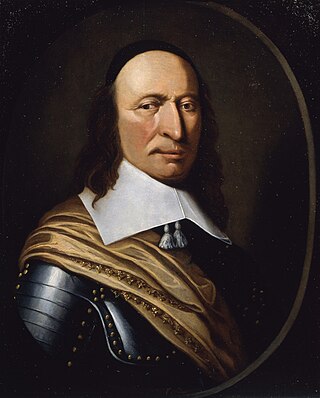
Peter Stuyvesant was a Dutch colonial officer who served as the last Dutch director-general of the colony of New Netherland from 1647 until it was ceded provisionally to the English in 1664, after which it was split into New York and New Jersey with lesser territory becoming parts of other colonies, and later, states. He was a major figure in the early history of New York City and his name has been given to various landmarks and points of interest throughout the city.
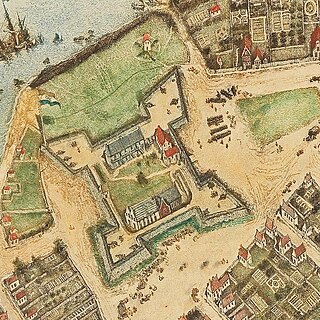
Fort Amsterdam was a fortification on the southern tip of Manhattan Island at the confluence of the Hudson and East rivers. The fort and the island were the center of trade and the administrative headquarters for the Dutch and then British/Colonial rule of the colony, of New Netherland and thereafter the Province of New York. The fort was the nucleus of the settlement on the island and greater area, which was named New Amsterdam by the first Dutch settlers, and eventually renamed New York by the English, and was central to much of New York's early history.

Willem Kieft, also Wilhelm Kieft, was a Dutch merchant and the Director of New Netherland from 1638 to 1647.
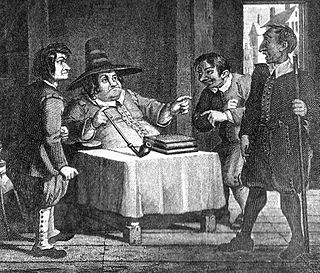
Wouter van Twiller was an employee of the Dutch West India Company and the fourth Director of New Netherland. He governed from 1632 until 1638, succeeding Peter Minuit, who was recalled by the Dutch West India authorities in Amsterdam for unknown reasons.
The Eight Men was a group of eight residents chosen by the people of New Netherland in 1643 to advise its Director-General, Willem Kieft, on his governance of the colony. An early form of representational democracy in colonial North America, it replaced the similarly selected Twelve Men and was followed by the Nine Men.

The Marble Collegiate Church, founded in 1628, is one of the oldest continuous Protestant congregations in North America. The congregation, which is part of two denominations in the Reformed tradition—the United Church of Christ and the Reformed Church in America—is located at 272 Fifth Avenue at the corner of West 29th Street in the NoMad neighborhood of Manhattan in New York City. It was built in 1851–54 and was designed by Samuel A. Warner in Romanesque Revival style with Gothic trim. The façade is covered in Tuckahoe marble, for which the church, originally called the Fifth Avenue Church, was renamed in 1906.
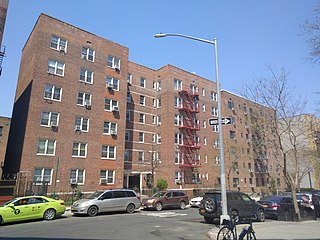
Bogardus Place is located in the Inwood section of New York City borough of Manhattan. The one-block street was opened in 1912, and runs 642 feet (196 m) between Hillside Avenue and Ellwood Street, and is named for the family who previously owned much of the land that forms both Fort Tryon Park, and the Fort Tryon section.
Cornelis Melyn was an early Dutch settler in New Netherland and Patroon of Staten Island. He was the chairman of the council of eight men, which was a part of early steps toward representative democracy in the Dutch colony.

New Netherlanders were residents of New Netherland, the seventeenth-century colonial outpost of the Republic of the Seven United Netherlands on the northeastern coast of North America, centered on the Hudson River and New York Bay, and in the Delaware Valley.

St. Nicholas Collegiate Reformed Protestant Dutch Church was a Reformed Protestant Dutch church in Midtown Manhattan, New York City, which was Manhattan's oldest congregation when it was demolished in 1949. The church was on the northwest corner of Fifth Avenue and 48th Street near Rockefeller Center. The church was built in 1872 to Gothic Revival designs in brownstone by architect W. Wheeler Smith and "distinguished by an elegantly tapered spire that, according to John A. Bradley in The New York Times, 'many declare…the most beautiful in this country.'" The congregation dated to 1628.
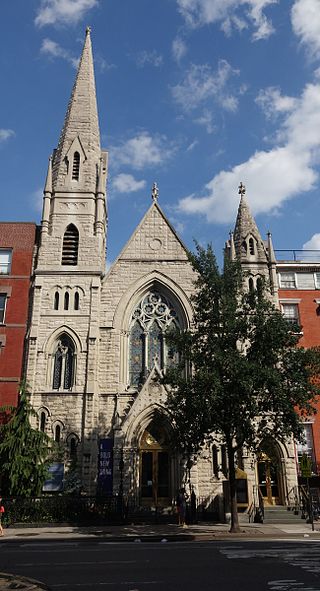
The Middle Collegiate Church is a dually aligned United Church of Christ and Reformed Church in America church located at 112 Second Avenue between 6th and 7th Streets in the East Village neighborhood of Manhattan, New York City.

Everardus Bogardus was the dominie of the New Netherlands, and was the second minister of the Dutch Reformed Church, the oldest established church in present-day New York, which was then located on Pearl Street at its first location built in 1633, the year of his arrival. Bogardus was, in fact, the second clergyman in all of the New Netherlands.
Princess Amelia was a Dutch merchant ship of 38 guns and 600 tons (bm) built in 1634 and wrecked off Swansea, Bristol Channel, in 1647. She served the Dutch West India Company and was one of the largest merchant ships of her day with 38 guns.

Jochem Pietersen Kuyter was an early colonist to New Netherland, and one of the first settlers of what would become Harlem on the island of Manhattan. He became an influential member of the community and served on the citizen boards known as the Twelve Men, the Eight Men and the Nine Men.
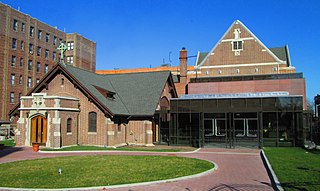
Fort Washington Collegiate Church is a Collegiate Reformed Protestant Dutch Church located at Magaw Place and 181st Street in the Washington Heights neighborhood of Manhattan, New York City.

Stuyvesant Farm, also known as the Great Bowery, was the estate of Peter Stuyvesant, the last Dutch director-general of the colony of New Netherland, as well as his predecessors and later his familial descendants. The land was at first designated Bowery No. 1, the largest and northernmost of six initial estates of the Dutch West India Company north of New Amsterdam, used as the official residence and economic support for Willem Verhulst and all subsequent directors of the colony.

Nechtanc was a Lenape settlement of the Canarsee located in what is now Two Bridges, Manhattan or the Lower East Side where the East River begins to turn north. In 1643, the settlement was the site of a massacre of Lenape people, mostly women and children, after the governor of New Netherland ordered the people killed as they slept. A simultaneous massacre occurred at Pavonia, just across the East River. The village is alternatively referred to in historical documents as Rechtauk.
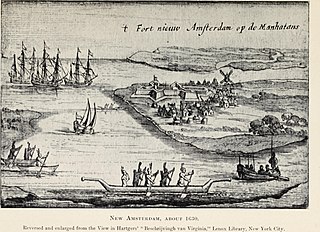
In September 1609, Henry Hudson, accompanied by around 20 sailors, navigated the Halve Maen into present-day New York Harbor. Tasked by the Dutch East India Company to discover a route to Asia, Hudson's journey instead led to the Dutch staking claim over an area they named Nieuw Nederland, encompassing what are now parts of the U.S. states of New York, New Jersey, Pennsylvania, Delaware, and Connecticut. Between 1625 and 1626, the newly formed Dutch West India Company founded a settlement at the southern tip of Manhattan to serve as the capital and main trading hub of the colony, dubbing it Nieuw Amsterdam, which would eventually evolve into New York City.




















